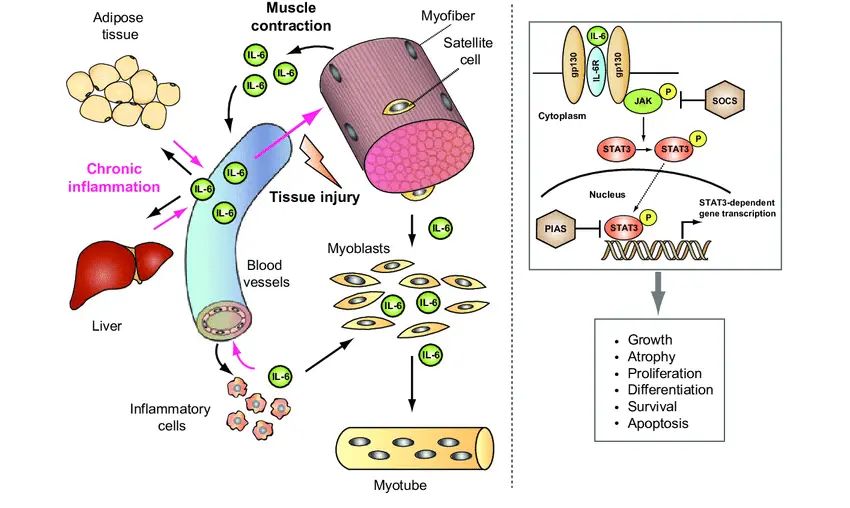
What is Interleukin-6?
Interleukin-6 (IL-6) is a type of cytokine that is produced by various cells in the body, including immune cells like T-cells and macrophages, as well as other cells such as endothelial and fibroblast cells. It’s involved in the regulation of the immune system, helping the body fight infections, inflammation, and injury. IL-6 has several important functions, including:
Immune Response
IL-6 helps activate the immune system when the body is faced with pathogens, like viruses and bacteria. It stimulates the production of acute-phase proteins by the liver, which are important for the body’s initial response to infection.
Inflammation Regulation
IL-6 plays a key role in inflammation, which is a defense mechanism against infection and injury. However, when this response is excessive or persistent, it can lead to chronic inflammation and tissue damage.
Cell Growth and Differentiation
IL-6 promotes the growth and differentiation of certain types of blood cells, including immune cells and red blood cells. It also helps in the production of other cytokines that further regulate immune activity.
Bone Metabolism
IL-6 is involved in the regulation of bone metabolism by promoting the differentiation of osteoclasts (cells that break down bone tissue) and osteoblasts (cells that form new bone tissue).
IL-6 and Disease
While IL-6 is crucial for normal immune functions, an overproduction or dysregulation of IL-6 can contribute to the development of various diseases. This is because IL-6 can cause excessive inflammation and immune system activation, leading to tissue damage and disease progression.
Autoimmune Diseases
In conditions like rheumatoid arthritis, systemic lupus erythematosus (SLE), and inflammatory bowel disease (IBD), IL-6 is often overprodued, contributing to chronic inflammation and tissue damage. In rheumatoid arthritis, for example, IL-6 contributes to the inflammation in joints, leading to pain and destruction of joint tissue.
Cancer
IL-6 has been found to play a role in the development of certain cancers, especially hematologic malignancies like multiple myeloma. In cancer, IL-6 promotes tumor growth by stimulating the production of other growth factors, enhancing the survival of tumor cells, and inducing angiogenesis (the formation of new blood vessels that feed tumors).
Chronic Inflammatory Diseases
Conditions such as cardiovascular disease, atherosclerosis, and diabetes are also linked to chronic low-grade inflammation, where IL-6 plays a significant role. Persistent IL-6 activity can increase the risk of developing these conditions by promoting ongoing inflammation and damaging blood vessels and tissues.
Acute Infections and Sepsis
During infections, IL-6 levels rise as part of the body’s inflammatory response. However, in severe infections like sepsis, IL-6 can become overactive and contribute to widespread inflammation, which can lead to organ failure and even death.
How IL-6 Works in the Body?

IL-6 signals through its receptor, which is found on various cell types, including immune cells, liver cells, and endothelial cells (cells that line blood vessels). When IL-6 binds to its receptor, it activates several intracellular signaling pathways, such as the JAK/STAT pathway, which helps transmit the signal to the cell’s nucleus, triggering gene expression changes that drive inflammation and immune responses.
IL-6 can act in two different forms:
- Classic Signaling: This occurs when IL-6 binds to its receptor on cell surfaces, triggering an immune response.
- Trans-Signaling: This occurs when IL-6 binds to a soluble form of its receptor, which can then interact with various cells in the body, leading to more widespread inflammation.
Targeting IL-6 for Treatment
Because IL-6 is so important in the development of many diseases, researchers have focused on finding ways to block its activity. The goal is to prevent IL-6 from binding to its receptor and triggering the harmful inflammatory response.

IL-6 Inhibitors
Drugs that block IL-6 activity are already in use for treating certain diseases. For example, tocilizumab, a monoclonal antibody that blocks IL-6R, is used to treat rheumatoid arthritis, systemic juvenile idiopathic arthritis, and cytokine release syndrome (CRS), a condition associated with certain cancer therapies.

Biosimilars
Biosimilars of IL-6 inhibitors, like sarilumab, offer more affordable alternatives to the original drugs. They work in the same way as the reference biologic, providing similar therapeutic benefits.

Clinical Trials and New Applications
Researchers are also testing IL-6 inhibitors in other diseases, such as cancer and COVID-19. In cancer, IL-6 inhibition may reduce tumor growth and improve responses to other therapies. In COVID-19, particularly in severe cases, IL-6 inhibitors are being studied to reduce the cytokine storm, a hyper-inflammatory response that can lead to severe lung damage and organ failure.
